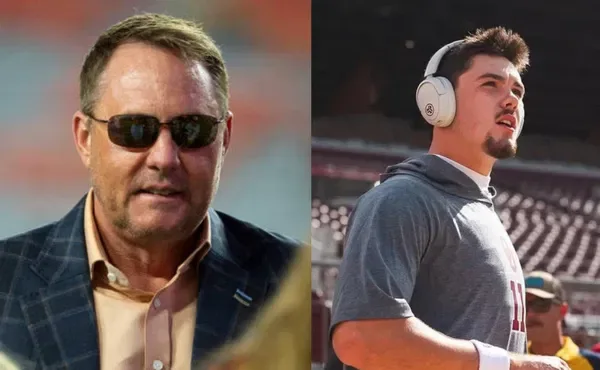When Jackson Arnold transferred to Auburn, it felt like the stars had finally aligned for Hugh Freeze. Here was a quarterback who could ignite the Tigers’ offense, someone with the kind of dual-threat dynamism that Freeze’s system thrives on. Arnold wasn’t just another name in the portal; he was the name—a quarterback with the arm strength to launch bombs downfield and the legs to leave defenders grasping at air. Auburn fans were ready to crown him the savior, and Freeze was ready to unleash him. But as the hype train barreled down the tracks, an all-too-familiar shadow from Arnold’s Oklahoma days threatened to derail everything.
From Sooner Savior to Sooner Survivor
Let’s rewind to Norman, where Arnold was pegged as the next great Sooner signal-caller. He had the pedigree, the poise, and the promise. A five-star recruit with a cannon for an arm and the wheels to escape trouble, he seemed destined to etch his name alongside Oklahoma legends. But 2024 wasn’t the fairytale season anyone expected. Sure, his stat line—154 completions on 246 attempts for 1,421 yards, 12 touchdowns, and just 3 interceptions—looked respectable on paper. But numbers rarely tell the full story, and Arnold’s tale was one of survival, not stardom.
The real culprit? Oklahoma’s offensive line was an absolute disaster. Injuries, inexperience, and inconsistency plagued the unit, turning every snap into a high-stakes game of “keep the QB alive.” The Sooners surrendered a jaw-dropping 46 sacks, ranking 132nd in the nation—just a few spots shy of rock bottom. Football analyst David Pollack didn’t mince words during his February 11th show: “I think Jackson Arnold was probably the big name because he started for Oklahoma, and I don’t know how to grade him because the offensive line for Oklahoma was terrible. It was awful.”
Pollack wasn’t exaggerating. Arnold spent more time evading defenders than reading them. By mid-season, the wear and tear showed, and he was benched in favor of true freshman Michael Hawkins. Though Arnold eventually clawed his way back into the starting lineup, the scars from that turbulent season were impossible to ignore.
Auburn’s Gamble: New Colors, Same Problems?
Fast forward to now: Arnold’s donning Auburn’s navy and burnt orange, and Freeze has a shiny new toy after a disappointing 5-7 season under Payton Thorne. But here’s the kicker—Freeze’s offense is tailor-made for quarterbacks like Arnold. Freeze isn’t looking for a pocket statue; he wants a magician, someone who can improvise when plays collapse. Arnold’s mobility and grit fit the bill perfectly.
Pollack even tipped his hat to Arnold’s potential in the Freeze system: “He’s a great runner, which fits the Freeze system… He’s really good with mobile guys, so that’s a big-time plus.” And Arnold wasted no time showcasing that in Auburn’s marquee game against Kalen DeBoer’s Alabama squad. His passing? Minimal—just 11 attempts for 68 yards. But on the ground? Pure electricity. Arnold racked up 131 yards on 25 carries, turning the Iron Bowl into his personal playground. Alabama’s defense had no answers, and for a brief moment, it felt like Freeze had found his perfect quarterback.
But—and it’s a big but—there’s a problem lurking beneath the surface. Auburn’s offensive line wasn’t exactly a fortress last year. The Tigers struggled to protect their quarterbacks, and their ground game sputtered more often than it soared. Sound familiar? That’s exactly the nightmare Arnold just woke up from in Oklahoma.
Hugh Freeze’s Biggest Puzzle: Protecting His Golden QB
Here’s where things get interesting. Auburn’s offensive line has been under major reconstruction, and on paper, it looks like they’ve laid a solid foundation. The projected starting five—Xavier Chaplin, Dillon Wade, Connor Lew, Jeremiah Wright, and Mason Murphy—bring a blend of experience, size, and talent that the Tigers desperately needed. And depth? Finally, Auburn isn’t scraping the bottom of the barrel. Bradyn Joiner, Dylan Senda, and Tyler Johnson are ready to step in if injuries strike, a luxury Auburn lacked last season.
But let’s not get ahead of ourselves. Last year’s O-line issues weren’t just about talent—they were about chemistry, execution, and durability. Freeze’s offense is dynamic, but it crumbles without solid protection upfront. The question now is simple but critical: Has Auburn done enough to keep Jackson Arnold upright?
If the answer is yes, the sky’s the limit. Arnold has the tools to light up SEC defenses—an arm that can stretch the field, legs that can break games wide open, and a mentality forged in the fires of Big 12 chaos. But if Auburn’s O-line falters? We could see a repeat of Norman’s nightmare, with Arnold spending more time picking himself off the turf than celebrating in the end zone.
The Stakes: Boom or Bust in the SEC Spotlight
Jackson Arnold’s Auburn journey is more than just a transfer story—it’s a high-stakes gamble with SEC implications. He’s stepping into a system built to amplify his strengths, but it’s also a system that will expose any lingering weaknesses, especially if the protection collapses. For Hugh Freeze, this isn’t just about winning games—it’s about proving that Auburn can rebuild and contend in one of the toughest conferences in college football.
So, what’s next? Will Jackson Arnold rise from the ashes of his Oklahoma struggles and become the hero Auburn needs? Or will the ghosts of his past come back to haunt him in the SEC? One thing’s for sure—this story is just getting started, and college football fans everywhere will be watching.
















